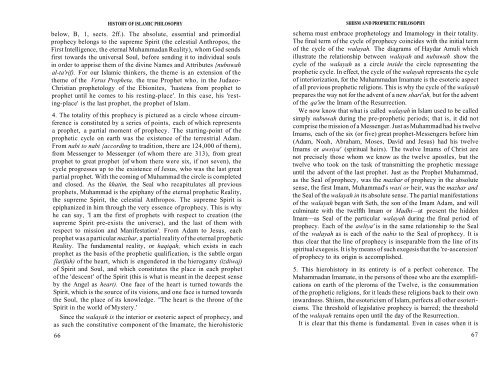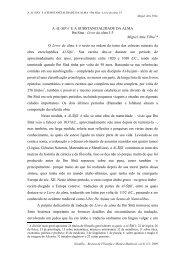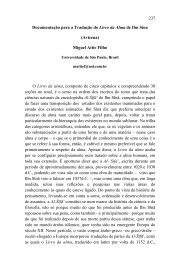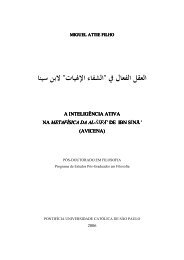History Of Islamic Philosophy - Henry Corbin.pdf - Falsafa
History Of Islamic Philosophy - Henry Corbin.pdf - Falsafa
History Of Islamic Philosophy - Henry Corbin.pdf - Falsafa
You also want an ePaper? Increase the reach of your titles
YUMPU automatically turns print PDFs into web optimized ePapers that Google loves.
HISTORY OF ISLAMIC PHILOSOPHY<br />
below, B, 1, sects. 2ff.). The absolute, essential and primordial<br />
prophecy belongs to the supreme Spirit (the celestial Anthropos, the<br />
First Intelligence, the eternal Muhammadan Reality), whom God sends<br />
first towards the universal Soul, before sending it to individual souls<br />
in order to apprise them of the divine Names and Attributes {nubuwah<br />
al-ta'rif). For our <strong>Islamic</strong> thinkers, the theme is an extension of the<br />
theme of the Verus Propheta, the true Prophet who, in the Judaeo-<br />
Christian prophetology of the Ebionites, 'hastens from prophet to<br />
prophet until he comes to his resting-place'. In this case, his 'resting-place'<br />
is the last prophet, the prophet of Islam.<br />
4. The totality of this prophecy is pictured as a circle whose circumference<br />
is constituted by a series of points, each of which represents<br />
a prophet, a partial moment of prophecy. The starting-point of the<br />
prophetic cycle on earth was the existence of the terrestrial Adam.<br />
From nabi to nabi {according to tradition, there are 124,000 of them),<br />
from Messenger to Messenger (of whom there are 313), from great<br />
prophet to great prophet {of whom there were six, if not seven), the<br />
cycle progresses up to the existence of Jesus, who was the last great<br />
partial prophet. With the coming of Muhammad the circle is completed<br />
and closed. As the khatim, the Seal who recapitulates all previous<br />
prophets, Muhammad is the epiphany of the eternal prophetic Reality,<br />
the supreme Spirit, the celestial Anthropos. The supreme Spirit is<br />
epiphanized in him through the very essence of prophecy. This is why<br />
he can say, 'I am the first of prophets with respect to creation (the<br />
supreme Spirit pre-exists the universe), and the last of them with<br />
respect to mission and Manifestation'. From Adam to Jesus, each<br />
prophet was a particular mazhar, a partial reality of the eternal prophetic<br />
Reality. The fundamental reality, or haqiqah, which exists in each<br />
prophet as the basis of the prophetic qualification, is the subtle organ<br />
[latifah) of the heart, which is engendered in the hierogamy (izdiwaj)<br />
of Spirit and Soul, and which constitutes the place in each prophet<br />
of the 'descent' of the Spirit (this is what is meant in the deepest sense<br />
by the Angel as heart). One face of the heart is turned towards the<br />
Spirit, which is the source of its visions, and one face is turned towards<br />
the Soul, the place of its knowledge. "The heart is the throne of the<br />
Spirit in the world of Mystery.'<br />
Since the walayah is the interior or esoteric aspect of prophecy, and<br />
as such the constitutive component of the Imamate, the hierohistoric<br />
66<br />
SHIISM AND PROPHETIC PHILOSOPHY<br />
schema must embrace prophetology and Imamology in their totality.<br />
The final term of the cycle of prophecy coincides with the initial term<br />
of the cycle of the walayah. The diagrams of Haydar Amuli which<br />
illustrate the relationship between walayah and nubuwah show the<br />
cycle of the walayah as a circle inside the circle representing the<br />
prophetic cycle. In effect, the cycle of the walayah represents the cycle<br />
of interiorization, for the Muhammadan Imamate is the esoteric aspect<br />
of all previous prophetic religions. This is why the cycle of the walayah<br />
prepares the way not for the advent of a new shari'ah, but for the advent<br />
of the qa'im the Imam of the Resurrection.<br />
We now know that what is called walayah in Islam used to be called<br />
simply nubuwah during the pre-prophetic periods; that is, it did not<br />
comprise the mission of a Messenger. Just as Muhammad had his twelve<br />
Imams, each of the six (or five) great prophet-Messengers before him<br />
(Adam, Noah, Abraham, Moses, David and Jesus) had his twelve<br />
Imams or awsiya' (spiritual heirs). The twelve Imams of Christ are<br />
not precisely those whom we know as the twelve apostles, but the<br />
twelve who took on the task of transmitting the prophetic message<br />
until the advent of the last prophet. Just as the Prophet Muhammad,<br />
as the Seal of prophecy, was the mazhar of prophecy in the absolute<br />
sense, the first Imam, Muhammad's wasi or heir, was the mazhar and<br />
the Seal of the walayah in its absolute sense. The partial manifestations<br />
of the walayah began with Seth, the son of the Imam Adam, and will<br />
culminate with the twelfth Imam or Madhi—at present the hidden<br />
Imam—as Seal of the particular walayah during the final period of<br />
prophecy. Each of the awliya' is in the same relationship to the Seal<br />
of the walayah as is each of the nabis to the Seal of prophecy. It is<br />
thus clear that the line of prophecy is inseparable from the line of its<br />
spiritual exegesis. It is by means of such exegesis that the 're-ascension'<br />
of prophecy to its origin is accomplished.<br />
5. This hierohistory in its entirety is of a perfect coherence. The<br />
Muhammadan Imamate, in the persons of those who are the exemplifications<br />
on earth of the pleroma of the Twelve, is the consummation<br />
of the prophetic religions, for it leads these religions back to their own<br />
inwardness. Shiism, the esotericism of Islam, perfects all other esotericisms.<br />
The threshold of legislative prophecy is barred; the threshold<br />
of the walayah remains open until the day of the Resurrection.<br />
It is clear that this theme is fundamental. Even in cases when it is<br />
67







